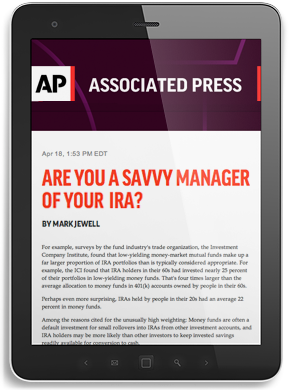Where To Put Your Money In 2012

Presenting an annual investment outlook is a hazardous task. At the start of 2011, investors were warned to eschew the bond market. Pundits described the low yields of U.S. Treasuries as a “bond market bubble.” In fact, if you had bought 30-year U.S. Treasury bonds at the start of the year when they yielded 4.42% and held them through 2011, when the yield had fallen to 2.89%, you would have earned a 34% return.
Meanwhile, U.S. stocks stayed flat, Europe and Japan declined by double digits, and emerging markets suffered even greater losses. Last year again demonstrated that it is virtually impossible to make accurate short-term predictions of asset returns.
But it is possible to make reasonable long-term forecasts. Let’s start with the bond market. If an investor buys a 10-year U.S. Treasury bond and holds it to maturity, he will make exactly 2%, the current yield to maturity. Even if the inflation rate is only 2%, the informal target of the Federal Reserve, investors will have earned a zero rate of return after inflation.
With a higher inflation rate, U.S. Treasuries will be a sure loser. Other high-quality U.S. bonds will fare little better. The yield on a total U.S. bond market exchange-traded fund (ticker BND) is only 3%. Bonds, where long-run returns are easy to forecast, are unattractive in the U.S. and Japan, as well as in Europe, where defaults and debt restructurings are likely.
Long-run equity return forecasts are more difficult, but they can be estimated under certain assumptions. If valuation metrics (such as price-earnings ratios) are constant, long-run equity returns can be estimated by adding the anticipated 2012 dividend yield for the stock market to the long-run growth rate of earnings and dividends. The dividend yield of the U.S. market is about 2%. Over the long run, earnings and dividends have grown at 5% per year.
Thus, with no change in valuation, U.S. stocks should produce returns of about 7%, five points higher than the yield on safe bonds. Moreover, price-earnings multiples in the low double digits, based on my estimate of the earning power of U.S. corporations, are unusually attractive today.
Stocks were losers to bonds in 2011. But don’t invest with a rear-view mirror. U.S. stocks, available in a broad-based index fund or ETF, are more attractive than bonds today. The same is true for multinational corporations throughout the world.
Investors in retirement, who desire a steady stream of income, can purchase a portfolio through mutual funds or ETFs tilted toward stocks paying growing dividends, with yields of 3% to 4%. And some areas of the bond market are attractive for investors who want some fixed-income investments. Tax-exempt funds that trade on exchanges (so called closed-end investment companies) that take on moderate amounts of short-term debt to increase the size of their portfolios have yields of 6% to 7%, and emerging-market bond funds have generous yields.
Emerging markets offer the best prospects for both equity and bond returns over the next 10 years. A number of fundamental factors favor the emerging economies. While Europe and the U.S. struggle with debt-to-GDP ratios of 100% or more—and Japan’s ratio is 250%—the fiscal balances of the emerging economies are generally favorable, and debt ratios are low. Low debt levels encourage economic growth.
Demography also favors the emerging economies. Dependency ratios (nonworking age to working age population) are far more favorable in emerging markets. Soon Japan will have as many non-workers as workers, and Europe and the U.S. are not far behind. Emerging markets, such as India and Brazil, will continue to have two to three workers for every nonworker. Even China, with its one-child policy, will have favorable demographics and a large potential labor force until at least 2025. Countries with younger populations tend to grow faster.
Natural-resource-rich countries will also benefit over the decade ahead. The world has a finite amount of natural resources and the relative prices of increasingly scarce resources will rise. Countries such as Brazil, with abundant oil and minerals, as well as water and arable land, will benefit from the world’s increasing demand.
Emerging stock markets were among the worst performers in 2011 despite their favorable economic performance and future outlook. Hence their stock valuations are unusually attractive relative to developed markets. Historically, emerging-market equities had price-earnings multiples 20% above the multiples for the S&P 500. Today, those multiples are 20% lower. And emerging-market bonds have significantly higher yields than those in developed markets.
Much worry has been expressed about real-estate prices and construction activity in China. “It’s Dubai times 1,000,” says one hedge-fund manager who predicts an economic collapse. Obviously, an end to China’s growth would be a significant blow to the world economy.
But parallels to the U.S. real-estate bust and the resulting damage to the economies and financial institutions of the Western world seem unwarranted. The absorption of vacant space remains extremely high in China, where hundreds of millions more people are expected to move from farms to cities. And unlike the U.S., where people bought new homes with little or nothing down, Chinese buyers make minimum down payments of 40% on a new home (and 60% on a second home).
In the U.S., savings rates fell to zero, and consumer-debt levels tripled relative to income. In China, savings rates as a percentage of income are one-third.
Most important, the government has the wherewithal and the flexibility to stimulate the economy and recapitalize banks if necessary. China has a debt-to-GDP ratio of only 17%. China’s growth will slow down from the breakneck pace of the last several years. But it will continue to grow rapidly, and a meltdown of the Chinese economy is highly unlikely.
The U.S. housing bust has made the single-family home an extremely attractive investment. House prices have fallen sharply, and 30-year mortgages are available for people with good credit at rates below 4%. Housing affordability has never been better.
Whatever the specific mix of assets in your portfolio at the start of 2012, you would do well to follow one crucial piece of advice. Control the thing you can control—minimize investment costs. That is especially important in a low-return environment. Make low-cost index mutual funds or ETFs the core of your portfolio and ensure that any actively-managed investment funds you purchase are low-expense as well.
Mr. Malkiel is the author of “A Random Walk Down Wall Street” (10th ed., paper, W.W. Norton, 2012).





